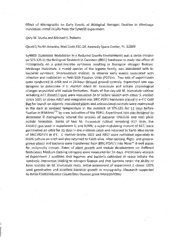
NASA Technical Reports Server (NTRS) 20110016176: Effect of Microgravity on Early Events of Biological Nitrogen Fixation in Medicago Truncatula: Initial Results from the SyNRGE Experiment PDF
Preview NASA Technical Reports Server (NTRS) 20110016176: Effect of Microgravity on Early Events of Biological Nitrogen Fixation in Medicago Truncatula: Initial Results from the SyNRGE Experiment
Effect of Microgravity on Early Events of Biological Nitrogen Fixation in Medicago truncatula: Initial resultsfrom the SyNRGE experiment. Gary W. Stutte and Michael S. Roberts QinetiQNorth America, Mail Code ESC-24, Kennedy Space Center, FL 32899 SyNRGE (Symbiotic Nodulation in a Reduced Gravity Environment) was a sortie mission on STS-135 in the Biological Research in Canisters (BRIe) hardware to study the effect of microgravity on a plant-microbe symbiosis resulting in biological nitrogen fixation. Medicago truncatula, a model species of the legume family, was inoculated with its bacterial symbiont, Sinorhizobium meliloti, to observe early events associated with infection and nodulation in Petri Dish Fixation Units (PDFUs). Two sets of experiments were conducted in orbit and in 24-hour delayed ground controls. Experiment one was designed to determine if S. meliloti infect M. truncatula and initiate physiological changes associated with nodule formation. Roots of five-day-old M. truncatula cultivar Jemalong A17 (Enodll::gus) were inoculated 24 hr before launch with either S. meliloti strain 1021 or strain ABS7 and integrated into BRIC-PDFU hardware placed in a4°C Cold Bagfor launch on Atlantis. Inoculated plants and uninoculated controls were maintained in the dark at ambient temperature in the middeck of STS-135 for 11 days before M fixation in RNAlate/ by crew activation ofthe PDFU. Experiment two was designed to determine if microgravity altered the process of bacterial infection and host plant nodule formation. Seeds of two M. truncatula cultivar Jemalong A17 lines, the Enodll::gus used in experiment 1, and SUNN, a super-nodulating mutant of A17, were germinated on orbit for 11 days in the middeck cabin and returned to Earth alive inside of BRIC-PDFU's at 4°C. S. meliloti strains 1021 and ABS7 were cultivated separately in broth culture on orbit and also returned to Earth alive. After landing, flight- and ground grown plants and bacteria were transferred from BRIC-PDFU's into Nunc™ 4-well plates for reciprocity crosses. Rates of plant growth and nodule development on Buffered Nodulation Medium (lacking nitrogen) were measured for 14 days. Preliminary analysis' of Experiment 1 confirms that legumes and bacteria cultivated in space 'initiate the symbiotic interaction leading to nitrogen fixation and that bacteria retain the ability to form nodules on M. truncatula roots. Initial assessment of experiment 2 shows 100% seed germination and excellent bacterial growth in microgravity. (Research supported by NASA ESMD/Advance Capabilities Division grant NNX10AR09A).
